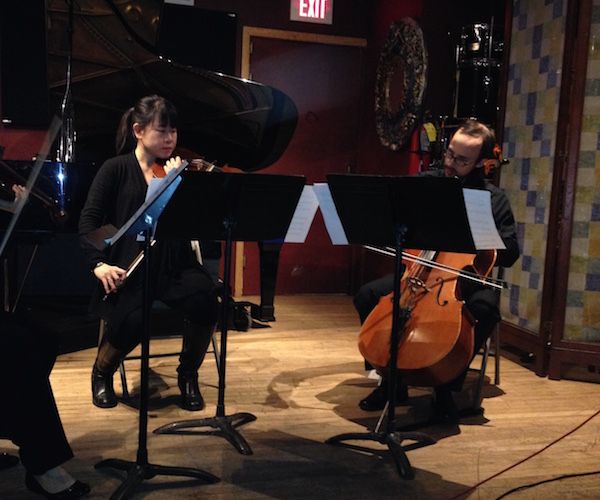Classical Music Review: The Composer Focus Series Asks — “Mozart?”
This performance of contemporary pieces inspired by Mozart came with a touch of the playfully interrogative.

Composer Focus Series performing at the Lily Pad. Photo: David Janssen.
By David Janssen
Composer Focus Series is currently in its second season, and last Sunday’s concert was the third of the four for the 2015-2016 season. Cellist Nick Dinnerstein created CFS because he wanted to expose audiences to rarely heard contemporary classical music. The concerts are held at the Lily Pad in Cambridge, a 92-seat performance space whose ‘local bar’ atmosphere encourages a relaxed approach to listening to challenging music, from jazz to classical. The theme of the evening was reactions to Mozart, featuring works by Dinnerstein, Alfred Schnittke, Arvo Pärt, pianist Paul Jacobs, and vocalist Mary Bichner. Dinnerstein, Bichner, and Jacobs played their own compositions. Violinists Sonia Deng and Yi-Li Chang and violist Chen Lin also performed. The question mark attached to Mozart’s name in the concert’s title pretty well summed up the peculiar relationship each composer had with Mozart — this was a performance in an interrogative key.
The two big names on the program, Pärt and Schnittke, both began their careers in the former Soviet Union. Unlike the generation of Shostakovich and Prokofiev, the two did not experience the terror of the Stalin purges. They matured in the 1970s and ’80s (around the time of Glasnost and the subsequent collapse of the U.S.S.R), so they could have more expressive and creative freedom. They were drawn to avant-garde currents in the west; Pärt embraced a type of spiritual minimalism, while Schnittke reveled in postmodern “collage’ techniques. The latter is often misinterpreted as a nihilistic prankster, his rash and irreverent juxtapositions of past styles seen as testaments to a meaningless existence. This is an overreaction: Schnittke is sardonic, but he cannot be reduced to that. In his work “Moz-art for Two Violins,” he takes material from an incomplete sketch Mozart composed for a Pantomime, which consisted of 12 miniature movements for a single violin with stage directions. Schnittke’s piece is more or less an exercise in divergent counterpoint in which the solo violin is doubled by another (at times mischievous) violin. The result is a Mozart Pantomime performed in Schnittke’s shadow. Mozart is not treated particularly disrespectfully, though it feels as if the modern composer is disengaged, a bit bemused by it all. The piece was played with animation by violinist Sonia Deng. The violinist Yi-Ling Chang did an excellent job accompanying the predominant first violin — she was a compliment rather than an irritant. The whistling and tuning peg elements were handled tastefully; accents rather than interruptions.
Pärt’s composition was also more of a homage to than a satire of the great composer. He took the adagio from Piano Sonata K. 280 (189e) and interpolated various gestures and tones, most noticeably in the meditative flanking sections in the violin and cello part. These Pärt-ian tones reflect the composer’s interest in genial dissonance. In Sunday’s performance, the musicians could have taken more time to evoke the placid lade mood in the outer added sections: that meditative atmosphere is necessary to make the piece work overall. What should have been a unifying element came off here as more of a confused and inconsequential add-on. The interior portions of the work fared better due to a better shaping of phrases.
Paul Jacob’s written ‘improvisation’ based on Mozart’s A minor Piano Sonata, K. 310 came in between performances of the Pärt and Schnittke. What begins as a straightforward rendition of the sonata wanders organically through various musical styles: from jazz to Shostakovich, from the rock band Radiohead and back to Mozart. Jacobs described his composition as a type of dream in which every random person seems to show up. As eclectic as the parade of styles might sound, Jacob’s source was never truly obscured. There were several moments where you couldn’t tell if Jacobs was making Mozart sound like Beethoven or a passage found in Mozart’s sonata sounded as if it could have been written by Beethoven. Jacob’s performance, technically adept and creative, expressed this playful, identity-mashing multiplicity brilliantly.
Last on the program were a set of songs composed for the concert by Boston-based composer Mary Bichner. Perhaps because of her background as a singer/songwriter, Bichner handles the stage naturally. Her five songs alluded to Mozart; they including an arrangement of the Don Giovanni aria “Deh Vieni Alla Finestra” as well as a tune about the paranoia Mozart experienced prior to his death. Her Björk-influenced vocal style, along with her genuine affection for the composer, confirmed the evenings unspoken theme “Me-and-My-Friend-Mozart” into the answer to the question raised by the concert’s title. Mozart? He’s our buddy.
Composer-Teacher David Janssen serves on the faculties of New Hampshire Institute of Art, Boston Baptist College, and Middlesex Community College teaching Music Appreciation and Theory. David’s list of works span several genres such as solo, chamber and orchestral music with performances in Prague, New York City, Boston and Oklahoma. The third movement of David’s Symphony No. 1 titled The Return of the Son of Man was a semi-finalist in the professional division of the national competition “The American Prize in Composition.” In December 2013, Canterbury Choral Society premiered David’s motet The Shepherds and the Angels in the Field. Current projects include Piano Sonata No.1, Violin and Cello Duo, and several professional recordings.
